FOOD SAFETY IN THE HOME
Governments and food companies are not the only ones with responsibility for maintaining food safety; consumers, too, must shoulder a portion of the burden. There are things that we can all do to increase the likelihood that the food we consume is safe. These actions—
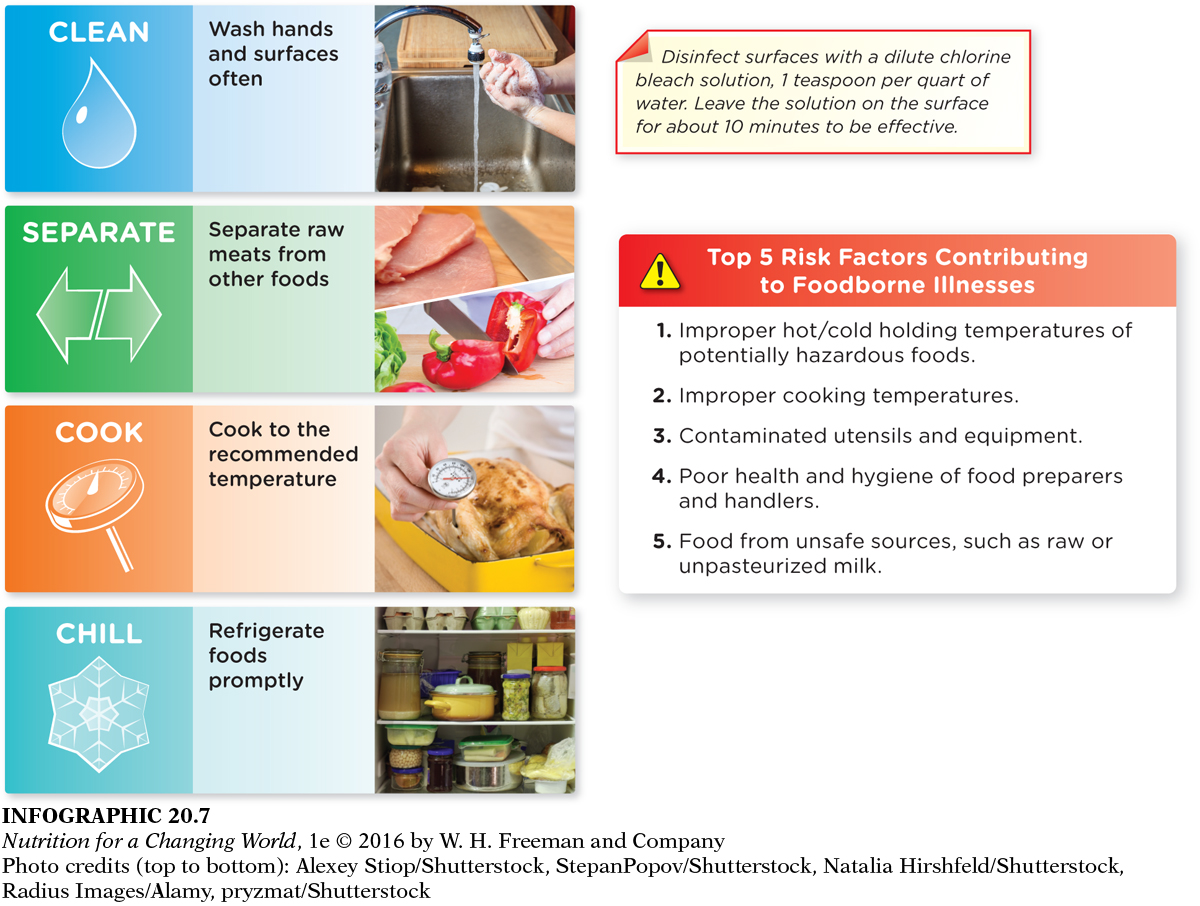
Question 20.6
 Identify which foodborne illness risk factors can be eliminated or reduced by each of these four steps to food safety.
Identify which foodborne illness risk factors can be eliminated or reduced by each of these four steps to food safety.
Proper hand washing and surface cleaning can prevent the contamination of utensils and equipment, as well as prevent problems associated with poor personal hygiene. Separating raw meats from other foods can prevent cross-
Pathogens can be found in many places in the kitchen including your hands, so food safety begins by thoroughly washing hands, countertops, cutting boards, and utensils. Proper hand washing will dramatically reduce the incidence of foodborne illnesses. Hands should be scrubbed for 20 seconds using soap and running water, being certain to wash the backs of your hands and under your nails. Hands should be washed frequently during food preparation, as well as after touching pets, using the bathroom, blowing your nose, handling garbage, and handling uncooked meats, poultry, fish, or eggs. It is also important to keep countertops, cutting boards, utensils, and dishes clean by washing with hot, soapy water (or a dilute bleach solution) after preparing each food item: Rinsing them with water is not effective at stopping the spread of foodborne infections.
Fresh fruits and vegetables should also be washed, even if you are planning to peel them before they are eaten. If they are not washed pathogens can be transferred from the outside of the peel to the edible portion as the produce is cut or peeled. Rinse produce under running water but do not use soap or bleach. Firm produce like melons, summer squash, and potatoes should be scrubbed under running water with a clean produce brush. (INFOGRAPHIC 20.8)

Avoiding cross-contamination of foods
To reduce our risk of foodborne illness it is also important to avoid cross-
The importance of appropriate food temperatures
To destroy pathogens in meat, poultry, seafood, and egg dishes cook them to a safe minimum internal temperature as measured with a probe thermometer. Ground meats must be cooked to a higher temperature than steaks, chops, or roasts because bacteria in ground meats are distributed throughout the meat rather than being concentrated on the surface of the meat.
Bacteria on the surface of meats are more easily destroyed because the surface of the meat reaches higher temperatures more quickly than internal portions of the meat. Because the bacteria found in raw poultry infiltrates deep into the meat, even whole, unground poultry must be cooked to a higher temperature than what is required for beef, pork, lamb, and veal. The safe minimum internal temperature for casseroles and leftovers is also set high because bacteria can be found throughout these foods, and not just on their surface. When heating foods in the microwave let them sit for about two minutes after heating (or follow the manufacturer’s instructions for commercial products) to reduce cold spots in the food and provide more time for bacteria to be destroyed. As long as foods have been handled properly before being cooked, following these cooking recommendations will make them safe to eat. However, if raw meats, ingredients for casseroles, or leftovers have not been kept at an appropriate temperature, bacteria may grow and produce toxins that may not be destroyed by cooking or reheating, causing foodborne illness. (INFOGRAPHIC 20.9)
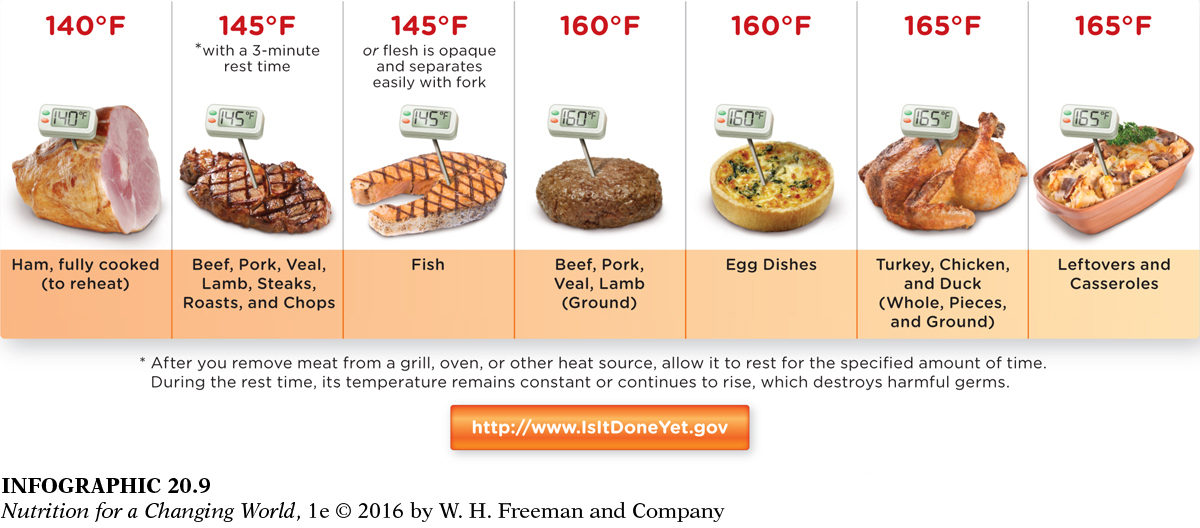
Question 20.7
 Why is the safe internal temperature of ground meats higher than it is for roasts or steaks of the same meat?
Why is the safe internal temperature of ground meats higher than it is for roasts or steaks of the same meat?
The safe internal temperature of ground meats is higher than some nonground meats because the grinding process breaks the meat into small portions and can distribute pathogens throughout the meat. Grinding increases the surface area for pathogens to adhere to and grow. Bacteria on the surface of meat is more easily destroyed. Because bacteria is distributed throughout raw poultry, nonground poultry must be cooked to a higher temperature as well.
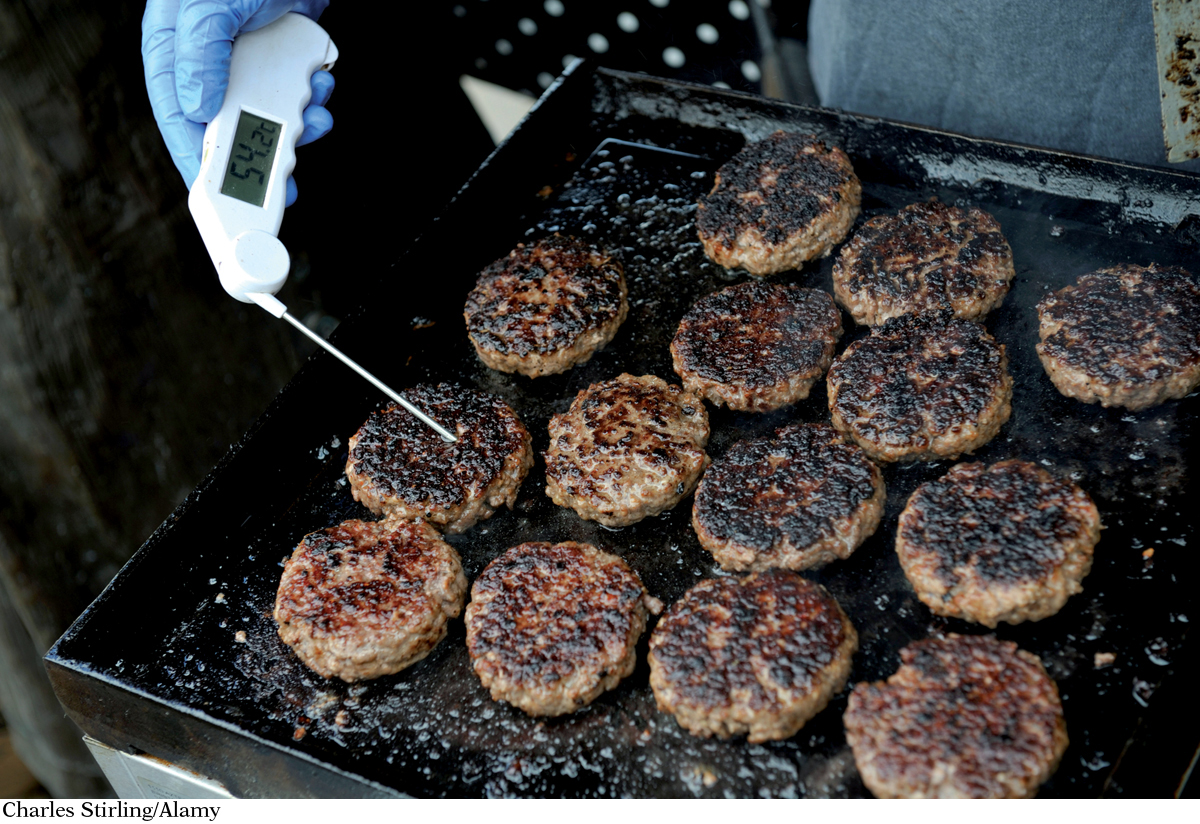
Promptly chilling perishable foods after purchase or preparation will also reduce bacterial growth in foods, thereby reducing the risk of both foodborne infections and intoxication. Leftovers should be refrigerated in shallow containers to allow for more rapid cooling. When leftovers are refrigerated in deep containers the food at the center can stay within the range of temperatures that promote bacterial growth (the temperature “danger zone”) for too long, allowing bacteria to multiply. When properly handled food is stored in the freezer at 0°F it will be safe for an indefinite period, however the flavor and texture of foods will deteriorate over time.
It is imperative to avoid the temperature danger zone. Bacteria grow at temperatures between 41°F and 135°F, and they grow particularly fast at temperatures between 70°F and 120°F. Keeping hot foods hot and cold foods cold is important, as is making sure that perishable foods never spend more than two hours in the temperature danger zone. Because bacteria multiply very quickly at room temperatures, meats and seafood should only be marinated in the refrigerator, and never on the kitchen counter. And never use the uncooked marinade on cooked foods as the bacteria from the raw foods will now be in the marinade as well. Keeping foods out for extended periods, such as at holiday or party buffets, potlucks, and picnics can create significant challenges to keeping food safe. During these types of events it is very important to keep hot foods at 135°F or higher and cold foods at 41°F or cooler. Care should also be exercised when thawing foods to be sure they do not spend a significant amount of time in the temperature danger zone. To avoid this never thaw foods on the kitchen counter, but thaw them in the refrigerator, in cold water, or in the microwave. (INFOGRAPHIC 20.10)

Question 20.8
 Why isn’t it necessary to immediately cook foods that have been thawed in the refrigerator?
Why isn’t it necessary to immediately cook foods that have been thawed in the refrigerator?
Foods thawed in the refrigerator are not exposed to the temperature danger zone and can be kept for a short time before they must be cooked. Ground meats and sausage must be cooked and used within two days; chops, roasts, and steaks should be cooked or frozen in three to five days.
As much as these actions can help prevent food poisoning, they are no substitute for food safety mechanisms at earlier points in the food production chain. For example, the spinach that was contaminated with E. coli would not have been made safe by washing, because the bacteria had infiltrated the inside of spinach leaves.
ORGANIC grown and processed using no synthetic fertilizers or pesticides
Ironically, the spinach that sickened so many people in 2006 was organic. Many people believe that organic produce is safer and perhaps even healthier than regular produce. But when it comes to foodborne pathogens that is often not the case. Organic means that no artificial fertilizers or pesticides were used in the growth of the food. For people who want to reduce exposure to synthetic pesticides, eating organic is a good way to accomplish this goal. But organic foods can just as easily become contaminated with harmful bacteria—
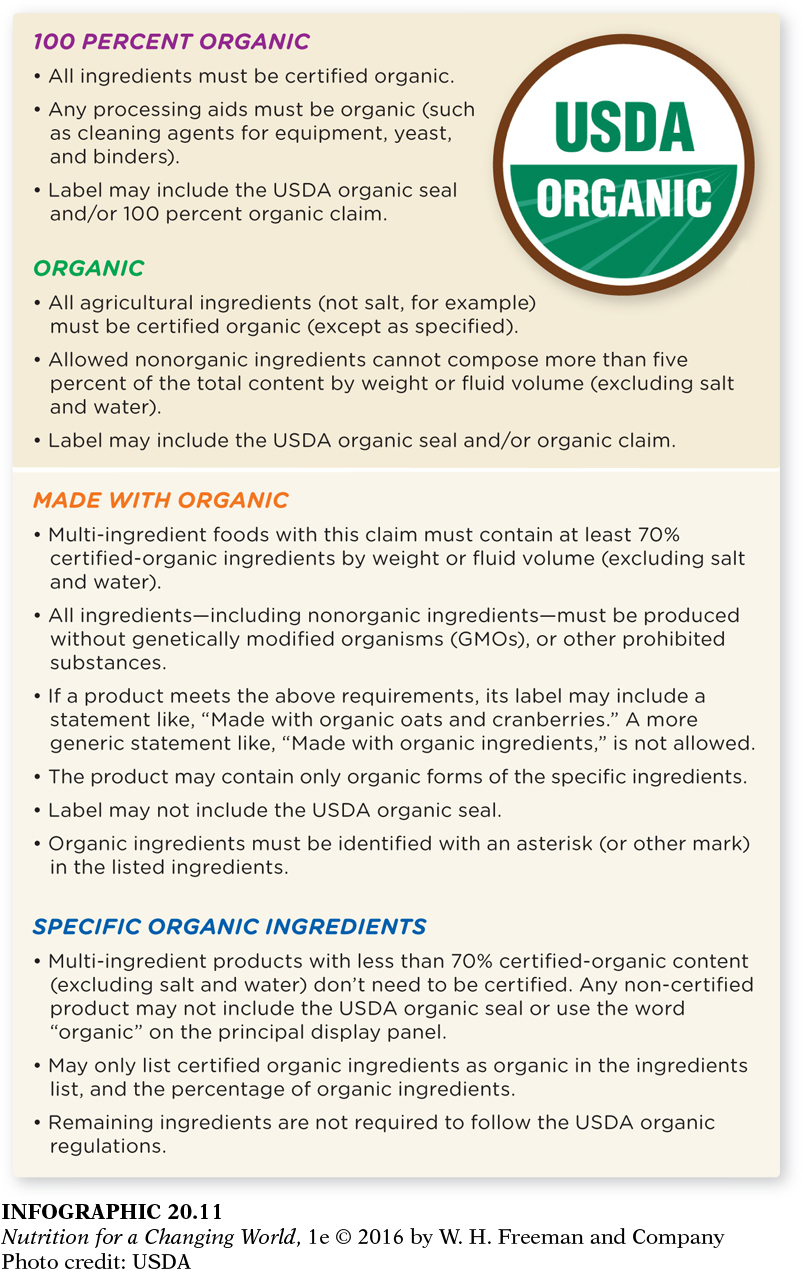
Question 20.9
 What is the minimum organic content of a food that is required for the label to display the USDA organic seal?
What is the minimum organic content of a food that is required for the label to display the USDA organic seal?
A food that bears the USDA organic seal may include 5% nonorganic ingredients by weight or fluid volume, but all agricultural ingredients (eg, coloring from fruits or spices) must be certified organic.
Food additives
FOOD ADDITIVES any substance added to a food product
As part of its role in ensuring a safe food supply, the FDA has primary responsibility for regulating substances that are added to food. Food additives are any substances added to food during processing, production, or preparation, including preservatives, flavorings, colorings, leavening agents (to improve consistency), and even vitamins and minerals. They can serve multiple purposes: to maintain or improve safety and freshness; to improve or maintain nutritional value; and to improve taste, texture, and appearance. Food manufacturers are required to list all ingredients in food products on food labels, including additives. (INFOGRAPHIC 20.12)
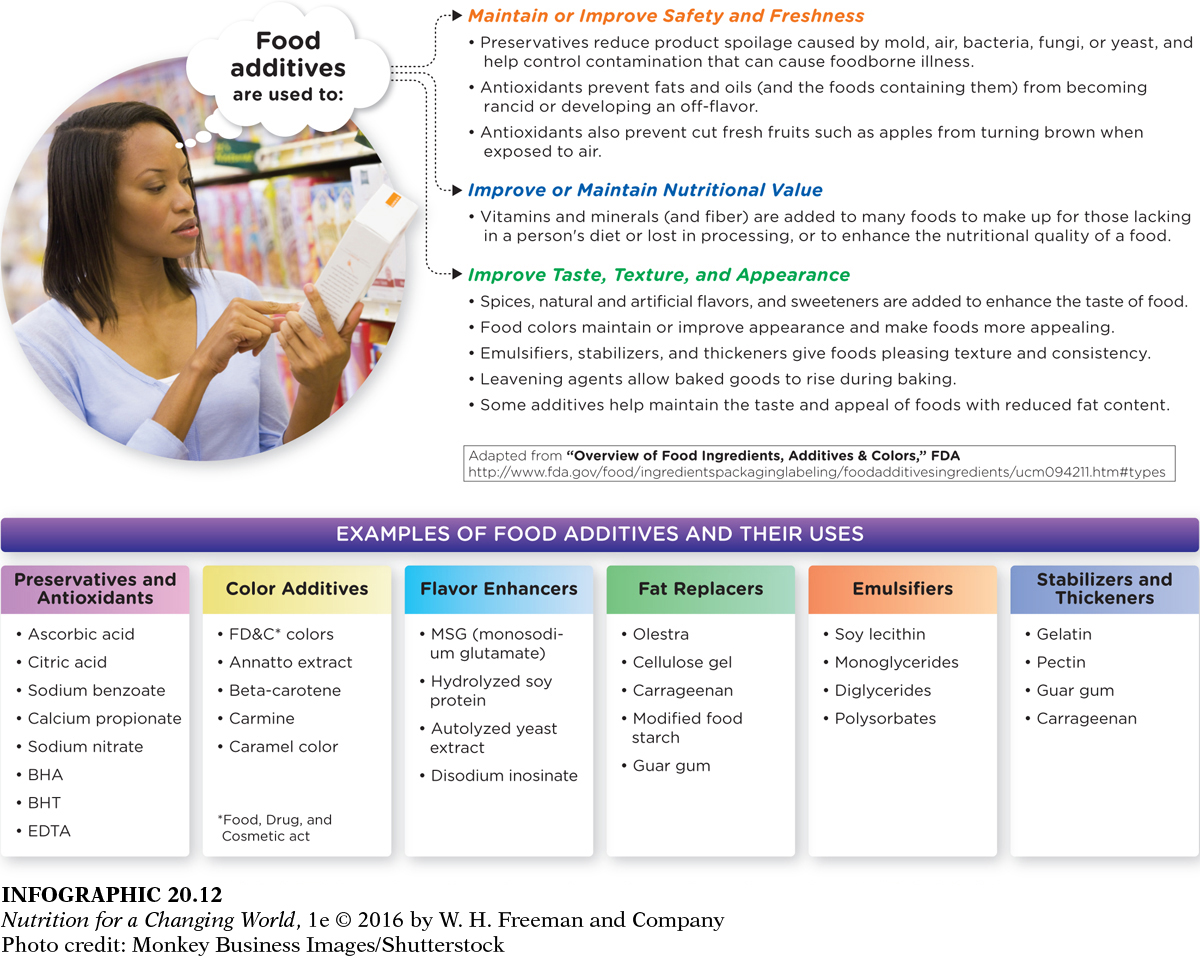
Question 20.10
 What type of food additive can increase food availability and variety?
What type of food additive can increase food availability and variety?
Preservatives and antioxidants improve the shelf life of foods and prevent spoilage during transportation. Food preservatives and antioxidants are used in dried fruits, wines, cured meats, baked goods, cheeses, condiments, and much more.
Direct food additives are often added during the processing of food and may be natural additives like spices, herbs, and salt, or manmade substances such as vitamins and chemical preservatives. Indirect additives are not intentionally added to foods, but are introduced into the food during packaging, processing, or storage. Indirect additives are generally present only in minute quantities and include compounds from packaging like paper fibers, adhesives, and compounds found in plastic food containers and metal-
The FDA has the primary legal responsibility for the safety of food additives and oversees the process for approval of food additives. The FDA is also responsible for determining the types of foods in which specific additives can be used, the maximum amount that can be used, and how it will be identified on the food label. Most additives in the food supply are considered “generally recognized as safe” (GRAS) on the basis of historical use in food and published studies on safe consumption. There are hundreds of substances on the GRAS list. Among these are common ingredients like salt, sugar, baking soda, vanilla, yeast, and spices. These substances do not have to go through an approval process. Although most food additives are GRAS, nutritionists generally agree that it is best to emphasize whole foods in one’s diet rather than processed foods that often contain multiple food additives.
Although most food additives have no adverse effects, there is now substantial evidence to support the theory that a high intake of artificial food colors (AFC) can cause small but statistically significant increases in hyperactivity in some children. A number of foods frequently consumed by children contain high amounts of AFC, including sodas, fruit and sports drinks, breakfast cereals, baked goods and frostings, and candies. Levels of AFC consumption by children in the United States can easily exceed the amounts that have most consistently been observed to have adverse effects. Some children are more susceptible to these effects than others.